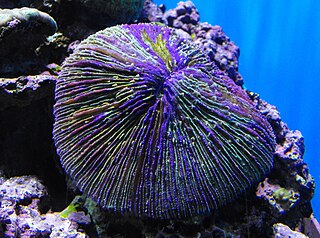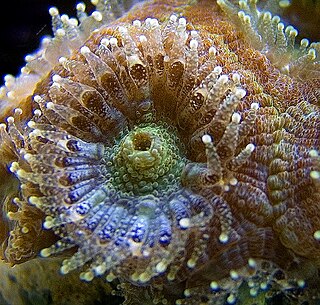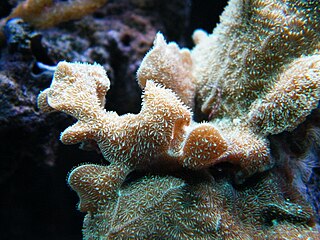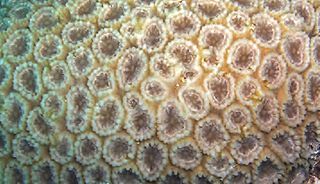
Anthozoa is a class of marine invertebrates which includes the sea anemones, stony corals and soft corals. Adult anthozoans are almost all attached to the seabed, while their larvae can disperse as part of the plankton. The basic unit of the adult is the polyp; this consists of a cylindrical column topped by a disc with a central mouth surrounded by tentacles. Sea anemones are mostly solitary, but the majority of corals are colonial, being formed by the budding of new polyps from an original, founding individual. Colonies are strengthened by calcium carbonate and other materials and take various massive, plate-like, bushy or leafy forms.

Scleractinia, also called stony corals or hard corals, are marine animals in the phylum Cnidaria that build themselves a hard skeleton. The individual animals are known as polyps and have a cylindrical body crowned by an oral disc in which a mouth is fringed with tentacles. Although some species are solitary, most are colonial. The founding polyp settles and starts to secrete calcium carbonate to protect its soft body. Solitary corals can be as much as 25 cm (10 in) across but in colonial species the polyps are usually only a few millimetres in diameter. These polyps reproduce asexually by budding, but remain attached to each other, forming a multi-polyp colony of clones with a common skeleton, which may be up to several metres in diameter or height according to species.

Mussidae is a family of stony coral in the order Scleractinia. Following a taxonomic revision in 2012, the family is now restricted to species found in the Atlantic Ocean, with Pacific species transferred to the new family Lobophylliidae. Many species are referred to as brain coral because their generally spheroid form and grooved surface resembles the convolutions of a brain.

Tubastraea, also known as sun coral or sun polyps, is a genus of coral in the phylum Cnidaria. It is a cup coral in the family Dendrophylliidae.

Fungia is a genus of corals in the family Fungiidae. It is monotypic with the single species Fungia fungites, which is found growing on reefs in the Indo-Pacific.

Poritidae is a family of stony corals. Members of the family are colonial hermatypic (reef-building) corals. They are variable in size and form but most are massive, laminar or ramose as well as branching and encrusting. The corallites are compact with very little coenosteum covering the skeleton. The walls of the corallites and the septa are porous. J.E.N. Veron considers the family is not a natural grouping but is a miscellaneous collection of genera that do not fit well elsewhere.

Micromussa lordhowensis, previously known as the 'Acan Lord', is a species of stony coral in the family Lobophylliidae. It is a widespread and common coral with large polyps occurring on shallow reefs in the Indo-Pacific Ocean. It was originally classified under the genus Acanthastrea, and reclassified under the genus Micromussa in 2016.

Pavona cactus, the cactus coral, potato chip coral or leaf coral, is a species of colonial stony coral in the family Agariciidae. This coral is found in shallow waters on reefs and in lagoons in tropical parts of the Indo-Pacific region.

Cynarina lacrymalis is a species of stony coral in the family Lobophylliidae. It is variously known as the flat cup coral, solitary cup coral, button coral, doughnut coral, or cat's eye coral. It is found in the western Indo-Pacific Ocean and is sometimes kept in reef aquaria.

Alveopora is a genus of colonial stony corals in the family Acroporidae. Members of this genus are native to the Indo-Pacific region and are often found on reef slopes in turbid water. They are generally uncommon.
Stylaraea is a genus of marine stony corals in the family Poritidae. It is a monotypic genus and the only species is Stylaraea punctata. This coral is native to shallow tidal pools in tropical parts of the Indian and Pacific Oceans.

Dipsastraea speciosa is a species of colonial stony coral in the family Merulinidae. It is found in tropical waters of the Indian and Pacific oceans.

Turbinaria peltata, commonly known as disc coral, is a species of colonial stony coral in the family Dendrophylliidae. It is native to the Indo-Pacific region. The International Union for Conservation of Nature has rated its conservation status as being "vulnerable".

Madracis auretenra, commonly known as the yellow finger coral or yellow pencil coral, is a colonial species of stony coral in the family Pocilloporidae. It is a fairly common species and is found in the Caribbean Sea and western Atlantic Ocean. At one time this species was not recognised, but it was split from Madracis mirabilis on the grounds of morphology and depth range.

Favites complanata is a species of stony coral in the family Merulinidae, sometimes known as the larger star coral. It is native to the Indo-Pacific region and its range extends from the Red Sea and Indian Ocean to the western and central Pacific Ocean. This is an uncommon species of coral and seems to be decreasing in abundance, and the International Union for Conservation of Nature has rated its conservation status as being "near threatened".

Platygyra daedalea, sometimes known as the lesser valley coral, is a colonial species of stony coral in the family Merulinidae. It occurs on reefs in shallow water in the Indo-Pacific region. It is a common species and the International Union for Conservation of Nature has assessed its conservation status as being of "least concern".

Blastomussa merleti, commonly known as pineapple coral, is a species of large polyp stony coral. It is unclear in which family the genus Blastomussa belongs. This coral is native to the west and central Indo-Pacific region and is sometimes used in reef aquaria.

Schizocyathus is a monotypic genus of stony corals in the family Schizocyathidae, the only species being Schizocyathus fissilis. It is a deep water, azooxanthellate coral.

Heterocyathus aequicostatus is a small species of coral in the family Caryophylliidae in the order Scleractinia, the stony corals. It is native to the Indo-Pacific region. It is a large polyp, solitary, free-living coral and is usually found on soft substrates.

Goniopora columna is a species of colonial stony coral in the family Poritidae.




















